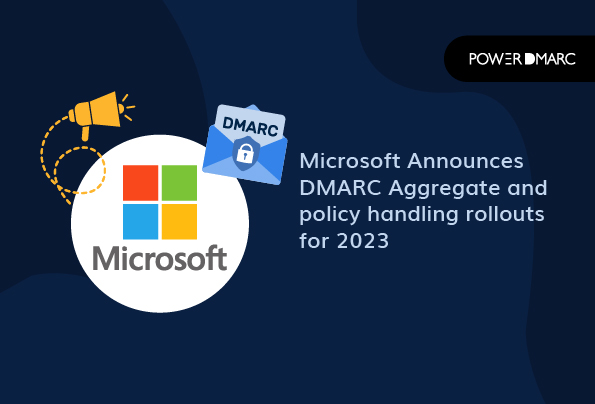Microsoft recently announced that it will be rolling out DMARC (Domain-based Message Authentication, Reporting, and Conformance) aggregate and policy handling features in 2023. This new development is a critical step toward strengthening email security and preventing email fraud.
Read Microsoft’s 2023 roadmap.
Introduction to DMARC
DMARC is an email authentication protocol that is designed to protect against email spoofing and phishing attacks. It works by enabling organizations to specify how incoming email messages should be handled if they fail authentication checks. With DMARC, email administrators can identify fraudulent emails that appear to be sent from their domains and prevent them from reaching their intended targets.
DMARC aggregate and policy handling features will enable organizations to better manage their DMARC policies and monitor the email activity of their domains. This development will provide a more efficient way to detect and respond to email spoofing attempts.
Microsoft’s history with DMARC
Microsoft has been working on DMARC for several years and has already implemented it in many of its products and services. The company has been a strong advocate for DMARC adoption and has encouraged other organizations to implement DMARC policies to improve email security.
The rollout of DMARC aggregate and policy handling features will further strengthen Microsoft’s commitment to email security. This development will enable organizations to better protect their email domains and prevent email fraud.
DMARC is an essential tool for email security, and its adoption is critical for protecting against email fraud. With the new DMARC aggregate and policy handling features, Microsoft is making it easier for organizations to implement DMARC policies and monitor their email activity.
How did Microsoft treat emails failing DMARC prior to the rollout?
Currently, Microsoft treats emails that fail DMARC authentication by quarantining them. This means that these emails are not delivered to the recipient’s inbox, but are instead placed in a quarantine folder.
It’s important to note that Microsoft’s current approach to DMARC handling differs from some other email providers who may reject emails that fail DMARC authentication. This means that if an email fails DMARC authentication, it will not be delivered to the recipient at all.
However, Microsoft has chosen to take a more cautious approach by quarantining emails that fail DMARC authentication, even if the sender is at a p=reject policy. This means that these emails will not be delivered to the recipient’s inbox, but will still be accessible in the quarantine folder.
This approach is designed to minimize the risk of false positives, which could occur if legitimate emails are rejected due to DMARC authentication failures. By quarantining these emails instead, Microsoft is providing email administrators with an opportunity to review the emails and determine whether they are legitimate or not.
It’s important to note that Microsoft’s approach to DMARC handling may change with the introduction of the new DMARC aggregate and policy handling features in 2023. However, for the time being, Microsoft’s approach to DMARC handling remains focused on minimizing the risk of false positives and providing email administrators with greater control over their email domains.
Why is rejecting emails that fail DMARC important?
Rejecting emails that are subject to DMARC fail is important because it helps to prevent email fraud and protect email users from phishing attacks.
When an email fails DMARC authentication, it means that the email is not legitimate and has been sent by someone pretending to be someone else. In other words, the email is a forgery and could be part of a phishing scam.
If an email provider rejects emails that fail DMARC authentication, it helps to ensure that email users do not receive these potentially dangerous messages. By rejecting these emails, email providers can effectively block them and prevent them from reaching their intended targets.
On the other hand, if an email provider only quarantines emails that fail DMARC authentication, it still provides some level of protection against email fraud, but it may not be as effective as rejecting these emails. Quarantining emails allows email administrators to review the messages and determine whether they are legitimate or not. However, this approach requires more time and resources, and there is always a risk that some fraudulent emails may slip through the cracks.
To Summarize
In conclusion, Microsoft’s announcement of DMARC aggregate and policy handling rollouts for 2023 is a significant step toward improving email security. Organizations should consider implementing DMARC policies to protect their email domains and prevent email fraud. With the new DMARC aggregate and policy handling features, Microsoft is making it easier for organizations to manage their DMARC policies and monitor their email activity, providing a more secure email environment for all.
- Rise in Tax Scams and IRS Email Impersonation Attacks During Tax Season - May 2, 2024
- Email Safety 101 to Fight Crypto Scams - April 30, 2024
- How to Find the Best DMARC Solution Provider for Your Business? - April 25, 2024
